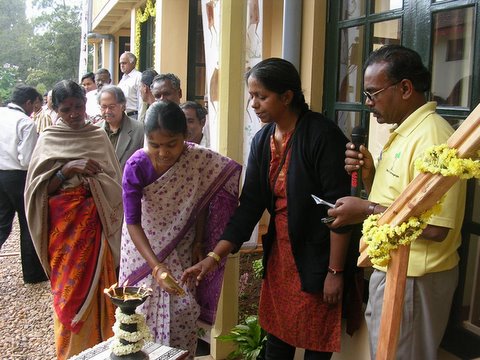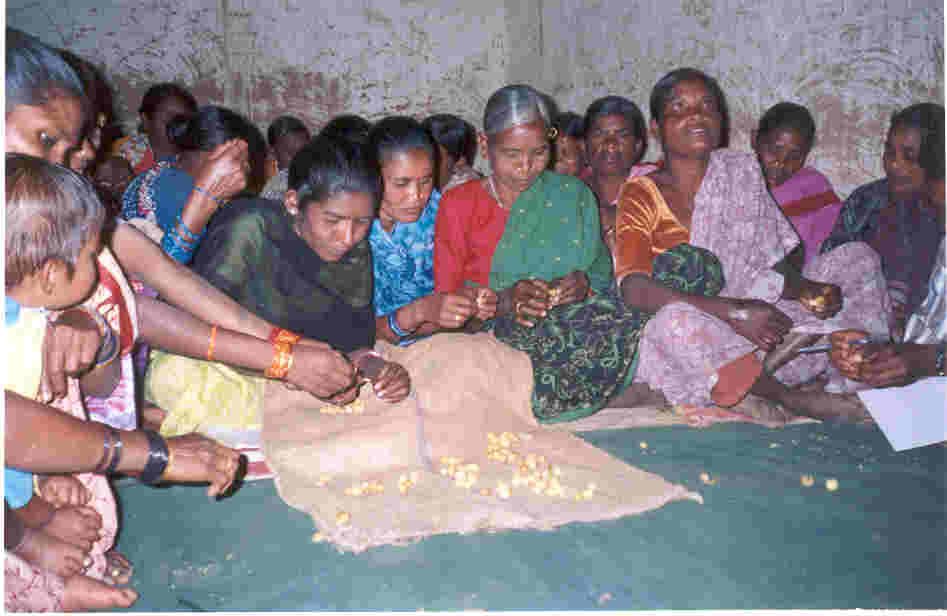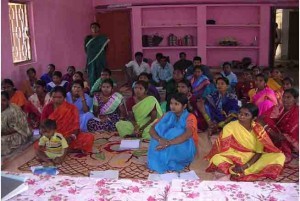From Palawan to the DENR: documenting & evaluating traditional NTFP management
In May, the community of Daan, Aporawan, Palawan, Philippines through the NATRIPAL (united Tribes of Palawan), hosted the NTFP Task Force’s field workshop on documenting and evaluating traditional methods of NTFP harvesting and management. It focused on three NTFPs – almaciga resin, rattan, and honey – resources which were held in common among these groups. The workshop was a follow-through of Dr. Mary Stockdale’s January visit, recommending a field test of the manual she authored Steps to Sustainable and Community-based NTFP Management. Dr. Stockdale is part of the NTFP-EP’s Virtual Academy.Alongside the workshop, photo-video documentation was undertaken. NTFP Task Force partners gained insights from Dr. Jon Corbett of the university of Victoria, Canada on the use of multi-media tools for documentation. An immediate output of the of the trip was a short film Mensahe Mula sa Kagubatan ( “Message from the Forest” ). The film became a springboard for advocacy on community-friendly policies on the access and use of the said resources. It was presented to policymakers of the Department of Environment and Natural Resources-Forest Management Bureau on 8 June and to academicians and researchers at the ASEAN Center for Biodiversity, University of the Philippines at Los Banos on 9 June. The presentation contributed to an opportunity to present a broader NTFP policy agenda to the DENR {see article
“Brad Pitts’ bed and Brazilian Honey”).
P3R artisans study tour on crafts
In July, a study tour was organised for six members of the artisans group of P3R (Association of Rattan Farmers and Craft Makers of Kedang Pahu, East Kalimantan). The journey brought the group to Bali, Jogyakarta and Jakarta, with the aim of studying the market for craft items in said locations. The study tour was rounded off with a workshop, organised by Dian Niaga, in Jakarta.
The latter meeting brought together people with both their feet in the trade, including a participant from Singapore, individuals with a background in design and techniques, as well as Nola Andaya of the CustomMade Crafts Center (CMCC) in Manila.
Not much later, a follow-up visit was made by Ibu Sylvia of PT Pilus, accompanied by EP craft support coordinator Indonesia, Yoga Sofyar and design specialist Ibu Alty of Dian Tama (Pontianak), to Kedang Pahu in order to discuss designs, prices and possible volumes.Since then, P3R has received firm orders from Pt Pilus and Bali-based ‘Threads for Life,’ while others have expressed interest in purchasing items from this source at a later date.
The initiative was made possible through support from NC-IUCN.
Multi-media for community advocacy
The power of multi-media as a vehicle for community advocacy was discussed by two experts within the EP network last June 2. Dr. Jon Corbett of the university of Victoria, Canada shared his experiences using participatory multi-media approaches for community information systems in Dayak tribes in Indonesia and for language revitalisation in First Nations in Canada. He emphasised the importance of the process that engages the community, given that participatory multimedia aims to enhance community capacity in generating, managing and communicating information and ultimately to encourage positive social change.
Meanwhile, Mr. Ridzki Sigit of Telapak discussed how they use film and what he terms as “development media” as a critical tool in investigating and monitoring issues in natural resource management. He presented a hard-hitting expose The Last Frontier of illegal logging of merbau in Papua, Indonesia. His crew posed as buyers of illegal logs, prompting discussion on the watchdog function of media and issues of security.
The forum was a sharing experience of similar work – advocacy-wise or media-wise – across various groups who joined the forum.
Sweet News from Indonesia
The Forest Honey Network Indonesia (Jaringan Madu Hutan Indonesia or JMHI) is steadily expanding, with most recently a honey cooperative from Sumbawa joining the fold.BioCert is on track with – a first – the organic certification of honey from Danau Sentarum, which is expected to be finalised immediately after the next harvest in the lake area, around February 2007.
A major launch in Indonesia of JMHI’s line of forest honeys has been postponed for April 2007. All efforts are at this stage focused on improving harvesting techniques, as well as at getting more sites at a higher quality level.Activities for 2006 culminated in the annual network meeting, this time hosted by the Kendari-based NGO Yascita and held in the village of Alahaa, Southeast Sulawesi.
The timing was good, as the event took place right in the middle of the harvesting season. Alahaa’s forest is very well preserved and contains vast honey resources. It turned out that the village cooperative has made tremendous progress since last year’s meeting, both in harvesting practices and proper handling of the product. Therefore, the village has been selected by BioCert to be the next in line for certification. Furthermore, the group from Riau showed its new flower designs for bees wax candles.
Keystone’s technical advisor, ‘Pak Leo,’ captured his audience with elaborate lectures on bee biology and demonstrations of testing and processing techniques. Leo is scheduled to be back in Indonesia next year.Finally, Johnny utama’s (of JMHI marketing arm Dian Niaga) much detailed explanations on such issues as pricing and costing, were also well received.
The meeting was rounded off with the participation of JMHI in a one-hour talk show ‘Bale-Bale’ on Yashita’s Kendari TV.
A New Decade for the Indigenous World: International Day of Indigenous Peoples (August 9)
In solidarity and support of the over 370 million indigenous people worldwide, 11 Philippine indigenous peoples groups – exhibited their achievements in assuring respect for their rights, cultural identity and development – through cultural performances and sales of indigenous products at the Edsa Shangri-La Plaza Mall, Metro Manila.
These organisations were the following: Earth Rights/Peoples Rights, Natripal, Lumad Development Center, Ilawan’s Tugdaan, upland Development Programme, Cordillera People’s Alliance, Tebtebba Foundation, Agmihicu, Bakun Indigenous Tribe Organization, Malupa and Kalahan Educational Foundation.
A cultural exhibition “A New Decade for the Indigenous World” also ran for a week.
The successful event, with over 100 in attendance, was a collaborative effort of the Delegation of the European Commission to the Philippines, the Embassy of Canada, International Labor Organization, Shangri-La Plaza Mall, and the NTFP-EP.
Of Philippine crafts and natural products
From 3-5 October, the Philippine NTFP-Task Force’s Crissy Guerrero attended the USAID/FRAME Natural Products Workshop. It aimed to strengthen value chains to become more effective mechanisms for addressing poverty reduction and conservation goals. This workshop builds on the existing knowledge sharing network for the natural resource community (www.frameweb.org).
Ms. Guerrero presented in the panel on Natural Products and the Distribution of Rural Benefits. She discussed how the CustomMade Crafts Center was developed as a mechanism to address the need for ongoing product development and marketing support for indigenous crafts. She highlighted the project’s benefits, including economic, as well as the questions arising with regards to benefit sharing and externalities.
The workshop was attended by over 100 persons from various sectors including the private sector (AVEDA, natural beauty care, products specialist; and S&D Aroma, distributor of fairly traded, FSC certified essential oils, etc.), researchers (CIFOR, Penn State university, Harvard university, Overseas Development Institute, etc.), government, NGOs (Conservation International, Enterprise Works Worldwide, Asian Network for Sustainable Agriculture & Bioresources), and community enterprises from different countries such as Malawi, Madagascar, Nepal, Senegal and the Philippines, among others.
Ecological monitoring workshop for NTFPs in India
Last 23-26 November, Keystone organised the Ecological Monitoring Workshop for NTFPs at Masinagudi Post, the Nilgiris, India. Some 34 representatives from India partners (EcoNet, Legal and Environmental Action Forum, Prakruti, and the Regional Centre for Development Corporation), convened for an orientation on practical steps to sustainable and community-based NTFP management from Dr. Mary Stockdale, a tropical forest expert from Canada and a member of the Virtual Academy of NTFP-EP.
The workshop aimed at understanding sustainable management practices of the major NTFPs in the states of Chattisgarh, Karnataka, Maharasthra, Orissa, and Tamil Nadu. Emphasis was given to a range of options on NTFP harvesting and management involving both local and scientific approaches, participatory monitoring and how these can be relevant to the participants’ own context.
Participants viewed two films produced through the NTFP-EP – “Message from the Forest” and “Eaglewood.” Participants also got the chance to appreciate nature through an exposure trip to the Madumalai Wildlife Sanctuary.
The semi-annual planning meeting of EP partners in India took place immediately after the workshop.
NTFP Conference Cambodia
The Ad Hoc NTFP Working group Cambodia got together twice, in June and September 2006 to prepare for the first national NTFP workshop to be held 7-8 December in Phnom Penh.
The group comprises representatives of local and international NgOs, government agencies and the academe. It aims to draw together data and experiences from forested areas all over the country in order to identify priority issues and activities for developing NTFP’s potential in Cambodia. Special attention will be paid to the role of NTFPs in improving the livelihoods of local communities, as well as to its potential contribution to forest conservation.
One day will be reserved for collectors groups and local NGOs and the event will be closed with a mini-film festival.
Advocating against forest conversion & plantation establishment at ASEAN parallel summit this December
The 2nd ASEAN Civil Society Conference (ACSC) will be held 10-12 December in Cebu City, Philippines coinciding with the annual ASEAN Summit. The conference seeks to consolidate and strengthen the advocacy of civil society of Southeast Asian countries to the ministerial level. This meeting will also include the the participation of the ASEAN secretariat as well as the Eminent Persons group (the group of respected individuals mandated by ASEAN to draft the ASEAN charter). Apart from tackling a broad range of priority issues affecting ASEAN this will also be an opportunity for civil society to prepare a declaration to ASEAN.
NTFP-EP sits in the ACSC panel on “Revisiting the Regional Commons” which looks into transboundary issues such as natural resource use and environment. The EP, along with Indonesian partners Sawit Watch and WWF-Indonesia, are using this panel specifically and the conference in general to discuss the concerns related to forest conversion, plantation establishment, and transboundary haze.
It is also an opportunity to engage with ASEAN Senior Officials on Environment (ASOEN). ASOEN is contemplating on institutionalizing a permanent civil society forum that the ministers would regularly engage with on environmental issues. The event will draw international press thus bringing greater attention to the statements and advocacy of civil society.
The attendance of Sawit Watch, World Wide Fund for Nature-Indonesia, and NTFP-EP is supported by the Nature and Poverty (N&P) Programme of Netherlands Committee-IuCN, Friends of the Earth-NL and WWF-NL.




